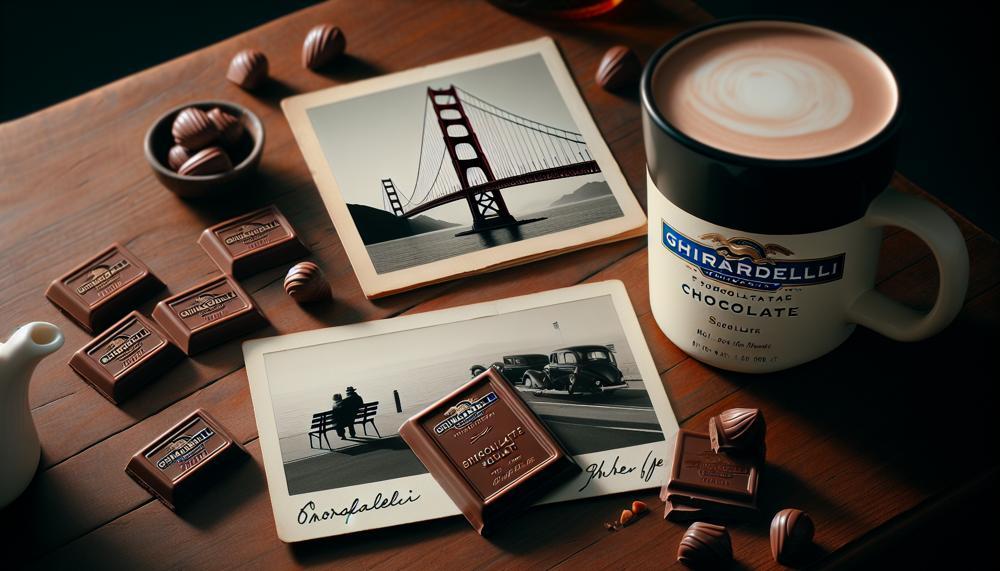Ghirardelli chocolate can last up to two years if unopened and stored properly, and one year if opened and stored properly. However, the best before date on the packaging indicates when the chocolate may start to lose its flavor. Chocolate can be safe to eat months or even years after its best by date, but you may notice differences in its taste or appearance.
Whether you savor their silky dark chocolate or indulge in their creamy milk chocolate, understanding the expiration of Ghirardelli chocolate is essential for maintaining its exceptional quality.
Contents
- 1 Factors Affecting Chocolate Shelf Life
- 2 Types of Chocolate and Their Shelf Life
- 3 Storing Ghirardelli Chocolate
- 4 Recognizing Spoilage and Quality Issues
- 5 Proper Usage for Baking and Cooking
- 6 How Long Does Chocolate Take to Go Bad?
- 7 Chocolate Bloom: What Is It?
- 8 How to Store Chocolate Properly
- 9 How to Tell If Chocolate Has Gone Bad
- 10 Conclusion
Key Takeaways:
- Ghirardelli chocolate can have a shelf life of several years if stored properly.
- The expiration of Ghirardelli chocolate depends on factors such as the type of chocolate, ingredients used, and storage conditions.
- Dark chocolate generally has a longer shelf life compared to milk and white chocolate.
- Proper storage involves keeping chocolate in a cool, dry place away from direct sunlight and strong odors.
- Checking the expiration date on the packaging is crucial for maintaining the quality of Ghirardelli chocolate.
Factors Affecting Chocolate Shelf Life
When it comes to the shelf life of chocolate, several factors come into play. One of the key factors is the cocoa content, which can vary depending on the type of chocolate. Dark chocolate, known for its intense flavor and rich cocoa content, generally has a longer shelf life compared to milk and white chocolate varieties.
Storage conditions also greatly influence the quality and longevity of chocolate. Proper temperature, moisture control, protection from light, and avoidance of strong odors are essential for preserving the taste and texture of chocolate.
Let’s take a closer look at these factors:
Cocoa Content
The cocoa content of chocolate refers to the percentage of cocoa solids present in the product. Dark chocolate typically has a higher cocoa content compared to milk and white chocolate. The higher the cocoa content, the longer the shelf life of the chocolate.
Storage Conditions
Storage conditions play a crucial role in maintaining the freshness and quality of chocolate. Here are some important factors to consider:
- Temperature: Chocolate should be stored in a cool environment, ideally between 60-70°F (15-21°C). Extreme temperature shifts can cause chocolate to develop a dull appearance and affect its overall quality.
- Moisture: Excessive moisture can cause chocolate to become sticky or develop a grainy texture. It is important to store chocolate in a dry environment to prevent moisture absorption.
- Light: Exposure to light can lead to the oxidation of chocolate, resulting in flavor degradation and potential color changes. Store chocolate in a dark place or use opaque packaging to protect it from light.
- Odors: Chocolate easily absorbs odors from its surroundings. To preserve its original taste and aroma, it’s best to store chocolate away from strong-smelling substances.
By taking these factors into account and following proper storage practices, you can extend the shelf life of your chocolate and ensure a delightful chocolate experience every time.
Types of Chocolate and Their Shelf Life
Different types of chocolate have varying shelf lives. Let’s explore the shelf life of different types of chocolate:
1. Dark Chocolate
Dark chocolate, with its high cocoa content and minimal milk additives, can stay in peak condition for approximately 2 to 3 years when stored properly.
2. Milk Chocolate
Milk chocolate, which has added milk solids and sugar, typically has a shorter shelf life of around 1 year.
3. White Chocolate
White chocolate, containing cocoa butter but no cocoa solids, also has a shelf life similar to milk chocolate.
| Type of Chocolate | Shelf Life |
|---|---|
| Dark Chocolate | 2 to 3 years |
| Milk Chocolate | 1 year |
| White Chocolate | 1 year |
It is important to note that these shelf life estimates are approximate and can vary depending on storage conditions. By following proper storage techniques, you can maximize the shelf life of your favorite chocolate.
Storing Ghirardelli Chocolate
Proper storage is crucial for maintaining the flavor and texture of Ghirardelli chocolate. Whether you plan to store it for the short or long term, following the right practices will ensure that your chocolate stays in optimal condition.
Short-Term Storage:
For short-term storage, it’s best to keep your Ghirardelli chocolate in a cool and dry pantry. The temperature in the pantry should be stable and not subject to fluctuations. This helps prevent heat damage and preserves the chocolate’s quality. Additionally, make sure to keep the chocolate away from direct sunlight, as exposure to light can cause it to melt or develop off flavors.
Long-Term Storage:
If you want to store Ghirardelli chocolate for a longer duration without compromising its taste and texture, freezing can be an option. However, it is important to freeze the chocolate correctly to avoid any damage to its structure.
Properly freezing Ghirardelli chocolate involves wrapping it tightly in plastic wrap or placing it in an airtight container to prevent moisture absorption. Make sure to label the package with the date and type of chocolate for easy identification later on. When you’re ready to enjoy the frozen chocolate, allow it to thaw gradually in the refrigerator or at room temperature to avoid condensation, which can lead to unwanted sugar bloom.
By following these proper storage practices, you can savor the rich and decadent taste of Ghirardelli chocolate any time you desire.
Recognizing Spoilage and Quality Issues
When it comes to chocolate, it is crucial to be able to distinguish between chocolate that has expired and chocolate that may have experienced a decline in sensory quality. While expired chocolate may develop a whitish film, known as bloom, on its surface, it is still safe to consume. However, changes in taste, texture, and appearance are indicative of spoilage. Trusting your senses and making informed judgments about the condition of the chocolate is essential.
When evaluating the quality of chocolate, consider the following factors:
- Taste: Pay attention to any off-flavors or unusual tastes. Spoiled chocolate may have a sour or rancid taste.
- Texture: Notice any changes in the texture of the chocolate. Spoiled chocolate may become grainy, dry, or have an unpleasant mouthfeel.
- Appearance: Examine the chocolate for any signs of mold, discoloration, or unusual spots. Spoiled chocolate may have visible signs of degradation.
It’s important to note that chocolate bloom, which can appear as either fat bloom or sugar bloom, does not indicate spoilage. Fat bloom occurs due to inconsistent temperature changes, while sugar bloom is caused by moisture exposure. Bloom affects the appearance and texture of chocolate but does not render it unsafe to consume.
Remember, trusting your senses is key when assessing the condition of chocolate. If the taste, texture, or appearance of the chocolate seems off, it may be best to discard it.
| Signs of Spoiled Chocolate | Safe to Consume |
|---|---|
| Taste: sour or rancid flavor | Expired chocolate with bloom |
| Texture: grainy or dry | |
| Appearance: mold, discoloration, or unusual spots |
By understanding the signs of spoilage and quality issues, you can ensure that you enjoy the best chocolate experience possible.
Proper Usage for Baking and Cooking
When it comes to baking and cooking with Ghirardelli chocolate, it’s important to understand the different types of chocolate and their characteristics. This knowledge will help you select the right chocolate for your recipes and achieve the desired flavor and texture in your dishes.
- Baking Chocolate: Baking chocolate, also known as unsweetened chocolate or bitter chocolate, is the purest form of chocolate. It contains a high percentage of cocoa solids and little to no sugar. This type of chocolate is ideal for recipes that call for a rich and intense chocolate flavor. It is perfect for making brownies, chocolate cakes, truffles, and other chocolate-centric desserts.
- Cocoa Powder: Cocoa powder is made by grinding the cocoa solids from chocolate liquor and removing most of the cocoa butter. It adds a deep chocolate flavor to baked goods and is commonly used in recipes for cookies, cakes, and hot chocolate. There are two main types of cocoa powder: natural and Dutch process. Natural cocoa powder has a lighter color and a more acidic taste, while Dutch process cocoa powder has a milder taste and a darker color.
- Dark Chocolate: Dark chocolate contains a higher percentage of cocoa solids and less sugar compared to other types of chocolate. It is known for its intense chocolate flavor and slightly bitter taste. Dark chocolate is often used in baking and cooking, especially in recipes that require a bold chocolate presence, such as chocolate soufflés, chocolate ganache, and chocolate mousse.
“Baking chocolate and cocoa powder are essential ingredients for achieving a rich and indulgent chocolate flavor in your baked goods.”
- Milk Chocolate: Milk chocolate is made by adding milk solids and sugar to the chocolate liquor. It has a smooth and creamy texture with a milder chocolate flavor. While milk chocolate can be enjoyed on its own, it is also suitable for baking and cooking. It works well in recipes that call for a sweeter and less intense chocolate taste, like chocolate chip cookies, chocolate fudge, and milk chocolate frosting.
- White Chocolate: Unlike dark and milk chocolate, white chocolate does not contain cocoa solids. It is made from cocoa butter, sugar, and milk solids. White chocolate has a rich and buttery flavor with a creamy texture. It adds a touch of sweetness to desserts and is often used in recipes for white chocolate cheesecake, white chocolate macadamia nut cookies, and white chocolate ganache.
Regardless of the type of chocolate you use, it is important to follow proper melting and mixing techniques to achieve the best results in your baked goods and dishes. Gentle heat and gradual melting ensure that the chocolate retains its smooth texture and glossy appearance.
Recommended Tips:
- Use a double boiler or a heatproof bowl set over a pan of simmering water to melt the chocolate. This gentle heat method helps prevent the chocolate from burning or seizing.
- Chop the chocolate into small, uniform pieces for even melting.
- Stir the chocolate constantly while melting to ensure it melts evenly and doesn’t overheat.
- Allow melted chocolate to cool slightly before incorporating it into your recipes for better texture and consistency.
By understanding the different types of chocolate and their characteristics, as well as employing proper melting and mixing techniques, you can elevate your baking and cooking endeavors with the rich and indulgent flavors of Ghirardelli chocolate.
How Long Does Chocolate Take to Go Bad?
When it comes to chocolate, the shelf life and expiration date can vary depending on several factors, including the type of chocolate and its quality. In general, chocolates with higher milk content, like milk chocolate and white chocolate, tend to have a shorter shelf life compared to dark chocolate.
Properly stored chocolate, especially if unopened, can still be consumed for months past its expiration date. However, it’s crucial to understand how to store chocolate correctly to maintain its quality and prevent it from going bad.
To illustrate the differences in shelf life, here’s a breakdown of the average expiration time for each type of chocolate:
| Type of Chocolate | Shelf Life |
|---|---|
| Dark Chocolate | 2 to 3 years |
| Milk Chocolate | 1 year |
| White Chocolate | 1 year |
It’s important to note that these are average guidelines, and individual brands may have slightly different expiration periods. Always check the packaging for the specific expiration date of the chocolate you have.
Additionally, proper storage is key to extending the shelf life. Keep chocolate in a cool, dry place away from direct sunlight and strong odors. Avoid exposure to moisture or extreme temperature changes, as these can affect the quality and taste of the chocolate.
By following these storage guidelines and paying attention to the expiration date, you can enjoy your favorite chocolate treats for an extended period.
Chocolate Bloom: What Is It?
Chocolate bloom refers to the appearance of a white film on the surface of chocolate. There are two types of bloom: fat bloom and sugar bloom.
Fat bloom occurs due to inconsistent temperature changes, while sugar bloom is caused by moisture exposure.
While bloom affects the appearance and texture of chocolate, it does not indicate that the chocolate has gone bad and is still safe to eat.
How to Store Chocolate Properly

When it comes to storing chocolate, proper storage techniques are essential to maintain its quality and prevent spoilage. Whether it’s your favorite Ghirardelli chocolate or any other type of chocolate, following these guidelines will help you preserve its flavor and texture for longer.
Choose the Right Storage Location
Find a cool, dry place to store your chocolate, such as a pantry or cabinet away from direct sunlight, temperature fluctuations, and moisture. Ideally, the temperature should be between 60°F (15°C) and 70°F (21°C).
Keep Chocolate in Its Original Packaging
Chocolate manufacturers often package their products in materials specifically designed to protect the chocolate from external factors. Whenever possible, keep the chocolate in its original packaging to maintain its freshness.
If the original packaging is damaged or opened, transfer the chocolate to an airtight container.
Wrap Chocolate in Plastic Wrap
If you need to store chocolate that is not individually wrapped, wrap each piece tightly in plastic wrap to prevent odor absorption.
This will help preserve the chocolate’s unique flavor and prevent it from picking up any unwanted smells.
Avoid Refrigeration Unless Necessary
While refrigeration can extend the shelf life of chocolate, it is generally not recommended unless you live in a hot climate or the chocolate is at risk of melting.
The moisture in refrigerators can cause chocolate to develop sugar bloom, affecting its texture and appearance.
Proper Freezing Techniques
If you want to store chocolate for an extended period or prevent it from melting, freezing can be an option. However, it’s crucial to use proper wrapping techniques to avoid moisture and condensation. Follow these steps when freezing chocolate:
- Wrap the chocolate tightly in plastic wrap or aluminum foil.
- Place the wrapped chocolate in an airtight freezer bag or container.
- Label the container with the date of freezing.
- To thaw frozen chocolate, transfer it to the refrigerator for several hours or let it come to room temperature gradually.
How to Tell If Chocolate Has Gone Bad
When it comes to spoiled chocolate, there are a few telltale signs to watch out for. These signs can help you determine if the chocolate is still safe to eat or if it’s time to discard it. Here are some common indicators of bad chocolate:
- Sour smell: If the chocolate has a sour or unpleasant odor, it may have gone bad. Trust your sense of smell, as it can often detect spoilage even before other signs become apparent.
- Mold: Mold growth on chocolate is a clear indication that it has spoiled. If you notice any fuzzy patches or green spots, it’s best to avoid consuming it.
- Cracks or discoloration: Chocolate that has cracked or developed a discolored appearance may not be safe to eat. These visual changes can be a result of moisture or heat exposure, leading to a decline in quality.
Conclusion
In conclusion, Ghirardelli chocolate, like any other chocolate, has an expiration date that depends on several factors. The type of chocolate, ingredients used, and storage conditions all play a role in determining its shelf life. Proper storage techniques are essential to maintain the flavor and quality of Ghirardelli chocolate.
By storing Ghirardelli chocolate in a cool, dry place away from direct sunlight and strong odors, you can extend its shelf life and prevent spoilage. Checking the expiration date on the packaging is also crucial to ensure you enjoy the chocolate at its best.
Remember that different types of chocolate have different shelf lives. Dark chocolate typically lasts longer than milk and white chocolate due to its higher cocoa content. However, regardless of the type, proper storage is key.
So, whether you have a sweet tooth or need chocolate for baking and cooking, remember to store your Ghirardelli chocolate properly to savor its delightful taste and avoid any unpleasant surprises. Enjoy the rich, decadent flavors of Ghirardelli chocolate by following these storage guidelines.
Source Links
- https://discover.texasrealfood.com/food-shelf-life/ghirardelli-chocolate
- https://www.ghirardelli.com/product-faqs/
- https://www.thepioneerwoman.com/food-cooking/cooking-tips-tutorials/a35470461/does-chocolate-go-bad/




